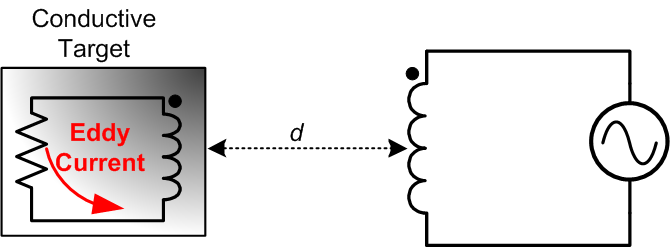SNOA954D November 2019 – June 2021 LDC0851 , LDC1001 , LDC1001-Q1 , LDC1041 , LDC1051 , LDC1101 , LDC1312 , LDC1312-Q1 , LDC1314 , LDC1314-Q1 , LDC1612 , LDC1612-Q1 , LDC1614 , LDC1614-Q1 , LDC2112 , LDC2114 , LDC3114 , LDC3114-Q1
2 Inductive Sensing Theory of Operation
An AC current flowing through an inductor will generate an AC magnetic field. If a conductive material, such as a metal object, is brought into the vicinity of the inductor, the magnetic field will induce a circulating current (eddy current) on the surface of the conductor.
The eddy current is a function of the distance, size, and composition of the conductor. The eddy current generates its own magnetic field, which opposes the original field generated by the sensor inductor. By opposing the original field, the original field is weakened; this produces a reduction in inductance compared to the inductors free-space inductance.
 Figure 2-1 Conductor in AC Magnetic
Field
Figure 2-1 Conductor in AC Magnetic
FieldAn EM field appropriate for sensing can be generated using an L-C resonator. One topology for an L-C tank is a parallel R-L-C construction, as shown in Figure 2-2. To simplify the inductor amplitude calculations, the parallel electrical model is generally used. For inductive sensing applications, the resistive element is represents parasitic circuit losses and is not a discrete component.
 Figure 2-2 Electrical Model of Parallel
Inductive Sensor
Figure 2-2 Electrical Model of Parallel
Inductive SensorThe circuit resonates at a frequency given by Equation 1:

Any shift in the target position causes the inductance value, L(d), to change, which in turn causes the resonant frequency to change. Hence, measuring the frequency change can be used to determine the inductance change, and therefore is based on the target position. In addition, by monitoring the amount of energy injected into the LC circuit, the RS(d) can be measured. TI’s various LDC devices use one or both of these two principles to determine the change in position of the target, depending on the specific device.
The Analog Wire blog post Inductive sensing: Should I measure L, RP or both? compares the two different measurement techniques and recommends the more appropriate parameter to monitor.